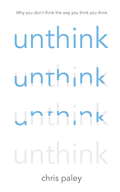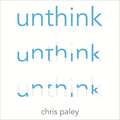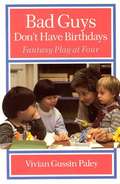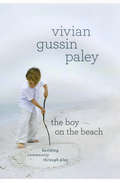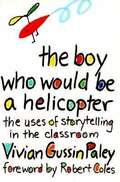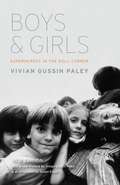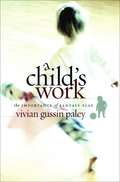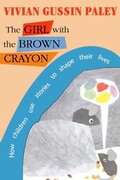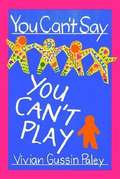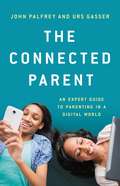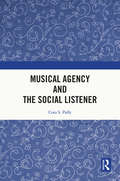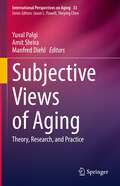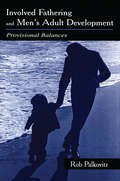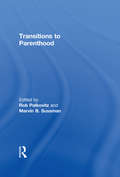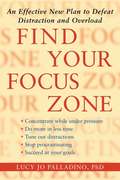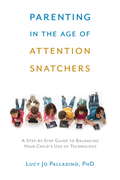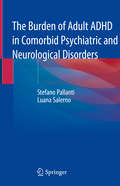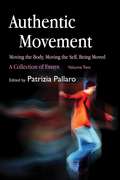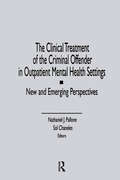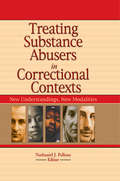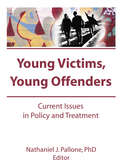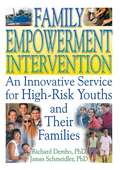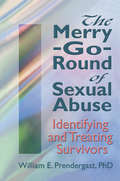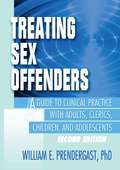- Table View
- List View
Unthink: And how to harness the power of your unconscious
by Chris PaleyYour life is dominated by your unconscious mind: by thoughts you're unaware of and movements you don't realise you are making. Words, colours, mannerisms and other cues you don't realise are affecting you, change what you think. The confidence you have in your ability to reason and to consciously choose what to do is caused by a series of illusions that scientists are only just beginning to understand. The discovery of these illusions will change the way we see ourselves more than the discoveries of Darwin and Copernicus. Unthink explores the unconscious decisions we make, and covers a variety of topics, ranging from how we choose politicians and romantic partners to more abstract subjects such as whether we can consciously decide to move our fingers. The counter-intuitive observations that Chris makes in the book include: · If you want someone to fancy you, wear red and meet them somewhere frightening. · When waitresses repeat customers' orders back to them instead of just saying 'yes' they receive bigger tips. · To reduce your shopping bill, start at the beer and snacks end of the store and work backwards. · If you sit someone in an upright chair when you give them good news they will be prouder of their achievements. · Having a picture of your family on your desk might make you work harder, but you'll be rattier when you get home! Chris Paley shows us how we can understand ourselves and others better, by having a greater understanding of the way that the unconscious mind has an impact of the way we live our lives.
Unthink: And how to harness the power of your unconscious
by Chris PaleyYour life is dominated by your unconscious mind: by thoughts you're unaware of and movements you don't realise you are making. Words, colours, mannerisms and other cues you don't realise are affecting you, change what you think. The confidence you have in your ability to reason and to consciously choose what to do is caused by a series of illusions that scientists are only just beginning to understand. The discovery of these illusions will change the way we see ourselves more than the discoveries of Darwin and Copernicus. Unthink explores the unconscious decisions we make, and covers a variety of topics, ranging from how we choose politicians and romantic partners to more abstract subjects such as whether we can consciously decide to move our fingers. The counter-intuitive observations that Chris makes in the book include:· If you want someone to fancy you, wear red and meet them somewhere frightening.· When waitresses repeat customers' orders back to them instead of just saying 'yes' they receive bigger tips.· To reduce your shopping bill, start at the beer and snacks end of the store and work backwards.· If you sit someone in an upright chair when you give them good news they will be prouder of their achievements.· Having a picture of your family on your desk might make you work harder, but you'll be rattier when you get home!Chris Paley shows us how we can understand ourselves and others better, by having a greater understanding of the way that the unconscious mind has an impact of the way we live our lives.
Unthink: And how to harness the power of your unconscious
by Chris PaleyYour life is dominated by your unconscious mind: by thoughts you're unaware of and movements you don't realise you are making. Words, colours, mannerisms and other cues you don't realise are affecting you, change what you think. The confidence you have in your ability to reason and to consciously choose what to do is caused by a series of illusions that scientists are only just beginning to understand. The discovery of these illusions will change the way we see ourselves more than the discoveries of Darwin and Copernicus. Unthink explores the unconscious decisions we make, and covers a variety of topics, ranging from how we choose politicians and romantic partners to more abstract subjects such as whether we can consciously decide to move our fingers. The counter-intuitive observations that Chris makes in the book include:· If you want someone to fancy you, wear red and meet them somewhere frightening.· When waitresses repeat customers' orders back to them instead of just saying 'yes' they receive bigger tips.· To reduce your shopping bill, start at the beer and snacks end of the store and work backwards.· If you sit someone in an upright chair when you give them good news they will be prouder of their achievements.· Having a picture of your family on your desk might make you work harder, but you'll be rattier when you get home!Chris Paley shows us how we can understand ourselves and others better, by having a greater understanding of the way that the unconscious mind has an impact of the way we live our lives.(P)2014 Hodder & Stoughton
Bad Guys Don't Have Birthdays: Fantasy Play at Four
by Vivian Gussin PaleyBad guys are not allowed to have birthdays, pick blueberries, or disturb the baby. So say the four-year-olds who announce life's risks and dangers as they play out the school year in Vivian Paley's classroom. Their play is filled with warnings. They invent chaos in order to show that everything is under control. They portray fear to prove that it can be conquered. No theme is too large or too small for their intense scrutiny. Fantasy play is their ever dependable pathway to knowledge and certainty. " It . . . takes a special teacher to value the young child's communications sufficiently, enter into a meaningful dialogue with the youngster, and thereby stimulate more productivity without overwhelming the child with her own ideas. Vivian Paley is such a teacher. " Maria W. Piers, in the "American Journal of Education" " Mrs. Paley's books] should be required reading wherever children are growing. Mrs. Paley does not presume to "understand" preschool children, or to theorize. Her strength lies equally in knowing that she does not know and in trying to learn. When she cannot help children because she can neither anticipate nor follow their thinking she strives not to hinder them. She avoids the arrogance of adult to small child; of teacher to student; or writer to reader. " Penelope Leach, author of "Your Baby & Child" in the "New York Times Book Review" " Paley's] stories and interpretation argue for a new type of early childhood education . . . a form of teaching that builds upon the considerable knowledge children already have and grapple with daily in fantasy play. " Alex Raskin, "Los Angeles Times Book Review" "Through the 'intuitive language' of fantasy play, Paley believes, children express their deepest concerns. They act out different roles and invent imaginative scenarios to better understand the real world. Fantasy play helps them cope with uncomfortable feelings. . . . In fantasy, any device may be used to draw safe boundaries. " Ruth J. Moss, "Psychology Today""
The Boy on the Beach: Building Community Through Play
by Vivian Gussin PaleyWhat can the richly imagined, impressively adaptable fantasy world of children tell us about childhood, development, education, and even life itself? Paley presents a wise appreciation of the importance of play and enduring curiosity about the nature of childhood and the imagination.
The Boy Who Would Be a Helicopter
by Vivian Gussin PaleyHow does a teacher begin to appreciate and tap the rich creative resources of the fantasy world of children? What social functions do story playing and storytelling serve in the preschool classroom? And how can the child who is trapped in private fantasies be brought into the richly imaginative social play that surrounds him? The Boy Who Would Be a Helicopter focuses on the challenge posed by the isolated child to teachers and classmates alike in the unique community of the classroom. It is the dramatic story of Jason-the loner and outsider-and of his ultimate triumph and homecoming into the society of his classmates. As we follow Jason's struggle, we see that the classroom is indeed the crucible within which the young discover themselves and learn to confront new problems in their daily experience. Vivian Paley recreates the stage upon which children emerge as natural and ingenious storytellers. She supplements these real-life vignettes with brilliant insights into the teaching process, offering detailed discussions about control, authority, and the misuse of punishment in the preschool classroom. She shows a more effective and natural dynamic of limit-setting that emerges in the control children exert over their own fantasies. And here for the first time the author introduces a triumvirate of teachers (Paley herself and two apprentices) who reflect on the meaning of events unfolding before them.
Boys & Girls: Superheroes in the Doll Corner
by Vivian Gussin PaleyWith the publication of Boys and Girls in 1984, Vivian Gussin Paley took readers inside a kindergarten classroom to show them how boys and girls play#151;and how, by playing and fantasizing in different ways, they work through complicated notions of gender roles and identity. The children’s own conversations, stories, playacting, and scuffles are interwoven with Paley’s observations and accounts of her vain attempts to alter their stereotyped play. Thirty years later, the superheroes and princesses are still here, but their doll corners and block areas are fast disappearing from our kindergartens. This new edition of Paley’s classic book reignites issues that are more important than ever for a new generation of students, parents, and teachers.
A Child's Work: The Importance of Fantasy Play
by Vivian Gussin PaleyThe buzz word in education today is accountability. In her new book, Vivian Gussin Paley decries this rapid disappearance of creative time and makes the case for the critical role of fantasy play in the psychological, intellectual, and social development of young children.
The Girl with the Brown Crayon
by Vivian Gussin PaleyOnce again Vivian Paley takes us into the inquiring minds and the dramatic worlds of young children learning in the kindergarten classroom. As she enters her final year of teaching, Paley tells in this book a story of farewell and a story of self-discovery—through the thoughts and blossoming spirit of Reeny, a little girl with a fondness for the color brown and an astonishing sense of herself. "This brown girl dancing is me," Reeny announces, as her crayoned figures flit across the classroom walls. Soon enough we are drawn into Reeny's remarkable dance of self-revelation and celebration, and into the literary turn it takes when Reeny discovers a kindred spirit in Leo Lionni—a writer of books and a teller of tales. Led by Reeny, Paley takes us on a tour through the landscape of characters created by Lionni. These characters come to dominate a whole year of discussion and debate, as the children argue the virtues and weaknesses of Lionni's creations and his themes of self-definition and an individual's place in the community. The Girl with the Brown Crayon tells a simple personal story of a teacher and a child, interweaving the themes of race, identity, gender, and the essential human needs to create and to belong. With characteristic charm and wonder, Paley discovers how the unexplored territory unfolding before her and Reeny comes to mark the very essence of school, a common core of reference, something to ponder deeply and expand on extravagantly.
You Can't Say You Can't Play
by Vivian Gussin PaleyWho of us cannot remember the pain and humiliation of being rejected by our classmates? However thick-skinned or immune to such assaults we may become as adults, the memory of those early exclusions is as palpable to each of us today as it is common to human experience. We remember the uncertainty of separating from our home and entering school as strangers and, more than the relief of making friends, we recall the cruel moments of our own isolation as well as those children we knew were destined to remain strangers.<P> In this book Vivian Paley employs a unique strategy to probe the moral dimensions of the classroom. She departs from her previous work by extending her analysis to children through the fifth grade, all the while weaving remarkable fairy tale into her narrative description. Paley introduces a new rule-"You can't say you can't play"-to her kindergarten classroom and solicits the opinions of older children regarding the fairness of such a rule. We hear from those who are rejected as well as those who do the rejecting. One child, objecting to the rule, says, "It will be fairer, but how are we going to have any fun?" Another child defends the principle of classroom bosses as a more benign way of excluding the unwanted.<P> In a brilliant twist, Faley mixes fantasy and reality, and introduces a new voice into the debate: Magpie, a magical bird, who brings lonely people to a place where a full share of the sun is rightfully theirs. Myth and morality begin to proclaim the same message and the schoolhouse will be the crucible in which the new order is tried. A struggle ensues and even the Magpie stories cannot avoid the scrutiny of this merciless pack of social philosophers who will not be easily caught in a morality tale.<P> You Can't Say You Can't Play speaks to some of our most deeply held beliefs. Is exclusivity part of human nature? Can we legislate fairness and still nurture creativity and individuality? Can children be freed from the habit of rejection? These are some of the questions. The answers are to be found in the words of Paley's schoolchildren and in the wisdom of their teacher who respectfully listens to them.
The Connected Parent: An Expert Guide to Parenting in a Digital World
by John Palfrey Urs GasserAn essential guide for parents navigating the new frontier of hyper-connected kids.Today's teenagers spend about nine hours per day online. Parents of this ultra-connected generation struggle with decisions completely new to parenting: Should an eight-year-old be allowed to go on social media? How can parents help their children gain the most from the best aspects of the digital age? How can we keep kids safe from digital harm? John Palfrey and Urs Gasser bring together over a decade of research at Harvard to tackle parents' most urgent concerns. The Connected Parent is required reading for anyone trying to help their kids flourish in the fast-changing, uncharted territory of the digital age.
Musical Agency and the Social Listener
by Cora S. PalfyMusic as a narrative drama is an intriguing idea, which has captured explicit music theoretical attention since the nineteenth century. Investigations into narrative characters or personae has evolved into a sub-field—musical agency. In this book, Palfy contends that music has the potential to engage us in social processes and that those processes can be experienced as a social interaction with a musical agent. She explores the overlap between the psychological processes in which we participate in order to understand and engage with people, and those we engage in when we listen to music. Thinking of musical agency as a form of social process is quite different from existing theoretical frameworks for agency. It implies that we come to musical analysis by way of intuition—that our ideas are already partially formed based on our experience of the piece (and what it makes us feel or how it makes us sense it as any other) when we choose to analyze and interpret it. Palfy’s focus on social processes is a very effective way to pinpoint when and why it is that our attention is captured and engaged by musical agents.
Subjective Views of Aging: Theory, Research, and Practice (International Perspectives on Aging #33)
by Yuval Palgi Amit Shrira Manfred DiehlThis book focuses on the concept of subjective views of aging. This concept refers to the way individuals conceptualize and perceive the aging process. Social and cultural perceptions regarding older adults are incorporated and internalized into views people hold regarding their own aging process. The book contains three parts which present theoretical, empirical, and translational perspectives about subjective views of aging. The theoretical section expands the framework of subjective views of aging with the inclusion of additional concepts, and further integrates these concepts by accounting for their synergistic effects. The empirical section presents recent developments in the field starting at the intra-individual level as assessed by ecological momentary assessments, going through the level of interpersonal relationships, and concluding at the social and cultural levels. Finally, the translational section presents recent endeavours to develop interventions aimed at advancing favourable views of aging. This cutting-edge edited book includes chapters written by internationally renowned scholars in the field and serves as an up-to-date resource for scholars in the field as well as a textbook for students in courses like social gerontology, lifespan psychology, and life course sociology.
Involved Fathering and Men's Adult Development: Provisional Balances
by Rob PalkovitzInvolved Fathering and Men's Adult Development is an interdisciplinary book that synthesizes theoretical, empirical, and anecdotal writings from different fields and provides an analysis of extensive interviews with 40 fathers. Along with the exploration of the distinct contribution that fathers make to their children's development, the author pursues the parallel theme of the effect this involvement has on the fathers' own development in adulthood. This book will provide its readers with a realistic and useful beginning point to bring a synthesis of developmental theories, family studies perspectives, and men's insights about fathering that will enhance our academic understanding of fathering and adult development. This book can also spark reflective and practical application for fathers and families, whether readers are academicians, practitioners, policymakers, or fathers in the trenches.
Transitions to Parenthood
by Robin J Palkovitz Marvin B SussmanIn this unusual but exciting look at a complex topic, family scholars offer a vast array of insights into the multiple consequences, concerns, and characteristics of parenthood. The transition to parenthood--the most critical step in individual and family life cycles--is thoroughly examined from a social psychological perspective. Cultural and ethnic factors are considered as major influences in the transition to parenthood, as are changing patterns in the work force, the consequences of the gender revolution, and altered patterns of marriage and divorce--all of which have shattered the traditional ways of parenting. Family theorists, practitioners, and parents are strongly encouraged to further research and discuss the necessary elements and available options involved in facing the changes brought on by parenthood.
Find Your Focus Zone
by Lucy Jo PalladinoBeing able to perform any task with full attention has become of the great unspoken-about challenges of modern life. As our culture has become more high-speed, techno-stressed, information-cluttered and media-saturated, we are getting pushed out of our focus zones without even realising it. If you work in a modern office, it is likely you are suffering from 'information fatigue syndrome', which means that even naturally bright and creative people are rendered incapable of making swift decisions, problem-solving efficiently or able to maintain appropriate energy levels. Award-winning psychologist Lucy Jo Palladino offers practical solutions for anyone juggling too much, who finds themselves in a state of 'continuous partial attention', seemingly unable to do any one task with full concentration. In order to help people combat the negative aspects of 'always-on' information culture, Palladino has come up with a new set of skills that will help readers beat distraction and win the fight against information overload. She provides eight sets of 'keys' that will unlock your best attention and help you balance adrenaline levels, even when you are under pressure or facing dull tasks. Rooted in sports performance psychology, yet practical and user-friendly, Palladino's cutting-edge methods will help you stay focused and enhance your performance in all areas of daily life where concentration is required.
Parenting in the Age of Attention Snatchers: A Step-by-Step Guide to Balancing Child's Use of Technology
by Lucy Jo PalladinoAre your kids glued to their screens? Here is a practical, step-by-step guide that gives parents the tools to teach children, from toddlers to teens, how to gain control of their technology use. As children spend more of their time on tablets and smartphones, using apps specially engineered to capture their attention, parents are becoming concerned about the effects of so much technology use--and they feel powerless to intervene. They want their kids to be competent and competitive in their use of technology, but they also want to prevent the attention and behavioral problems that can develop from overuse.In this guide, Lucy Jo Palladino doesn't demonize technology; instead she gives parents the tools to help children understand and control their attention--and to recognize and resist when their attention is being "snatched." Palladino's straightforward, evidence-based approach applies to kids of all ages. Parents will also learn the critical difference between voluntary and involuntary attention, new findings about brain development, and what puts children at risk for attention disorders.
The Burden of Adult ADHD in Comorbid Psychiatric and Neurological Disorders
by Stefano Pallanti Luana SalernoThis book highlights the importance of investigating for ADHD in adults with attention difficulties, poor memory and executive function impairments. The authors advocate a neurodevelopmental assessment approach in all phases of life, and explain how to perform such assessments. The identification of ADHD in adults with other psychiatric and neurological disorders will lead to a better response to treatments, and as a result reduce its social, economic and personal burden. ADHD can no longer be considered solely a pediatric condition, as it occurs in a significant proportion of adults worldwide. However, ADHD in adults is often unrecognized and untreated. Diagnosing the disorder in adulthood is a challenge, due not only to the different clinical presentation in this phase of life, but also to the fact that other conditions may mask the symptoms. ADHD constitutes a hidden comorbidity with a detrimental impact of those affected, and a poor response (or even non-response) to several treatments. Intended for psychiatrists, neurologists, specialists in gerontology and neuropsychology, this book is an indispensable resource for all mental health practitioners who want to optimize the treatment of patients affected by psychiatric and neurological disorders who respond poorly to standard treatments.
Authentic Movement: A Collection of Essays - Volume Two
by Patrizia PallaroPraise for the first volume: `It is very valuable to have [this collection of articles] all together in one place...a rich repository of insights and experiences for all the somatic disciplines. It is a wonderful collection of articles.' - Somatics 1999/2000 This second volume on Authentic Movement - a new discipline aiding the creative process in choreography, writing, theatre performance, dance, graphic and expressive arts, as well as spirituality - is an engaging and dynamic collection of scholarly essays, personal stories, practical suggestions and resources. It reflects cutting edge work on creative expression, meditative discipline and psychotherapeutic endeavour. Part I comprises five chapters written by the most prominent Authentic Movement practitioners and teachers and introducing the foundations and principles of Authentic Movement. In Part II, the contributors return to the source of Authentic Movement - the psychotherapeutic setting - and provide an in-depth examination of the personal processes in the therapeutic relationship and the potential of Authentic Movement to facilitate personal growth and change. Part III traces the development of Authentic Movement as a spiritual path and as interface with other spiritual practices. Part IV provides an overview of new developments in Authentic Movement, Part V offers inspiring personal accounts and Part VI provides guidelines drawn from practice as well as tools and resources. These latter chapters sow the seeds for a new understanding and directions for the developments of Authentic Movement. This authoritative text is indispensable for practitioners of Authentic Movement, students and teachers working in the field of dance therapy, art therapists, all creative arts therapists and body psychoanalysts.
The Clinical Treatment of the Criminal Offender in Outpatient Mental Health Settings: New and Emerging Perspectives
by Letitia C PalloneThis volume brings together in a single source a set of perspectives by leaders in the clinical treatment of criminal offenders in outpatient settings, particularly those whose crimes have involved domestic violence and/or substance abuse. More than a set of “how to” techniques, it addresses the question of which offenders can successfully be treated in what settings by which techniques. It is a valuable resource not only for those concerned with prisons, probation, and parole, but also for those responsible for the delivery of mental health services in the community.
Treating Substance Abusers in Correctional Contexts: New Understandings, New Modalities
by Letitia C PalloneGet the latest information on new and emerging modalities for treating drug-involved offenders! Treating Substance Abusers in Correctional Contexts: New Understandings, New Modalities analyzes the shift in policy and attitude away from two decades of the harsh punishment that characterized the war on drugs toward a more treatment-oriented "medicalization" of the problem. Edited by Dr. Nathaniel J. Pallone, editor of the Journal of Offender Rehabilitation (Haworth), the book presents an overview of new and emerging models for treatment of drug-involved offenders in a variety of settings. An international panel of authors examines the "rather treat than fight" approach to the war on drugs proposed by the voters of California, the Governor and criminal court judges of New York, and Gen. Barry McCaffrey, former Director of the White House Office of National Drug Control Policy. Treating Substance Abusers in Correctional Contexts looks at treatment modalities available to offenders inside and outside correctional institutions, with community organizations and mental health and social service agencies enlisted in a continuum of care as the courts and criminal justice system provide oversight-and often, funding. The book explores types of treatment that operate under the surveillance of courts and the criminal justice system, ranging from in-house programs for offenders under confinement in prisons and jails to residential substance abuse treatment (RSAT) and substance abuse treatment (SAT) programs in the community. Through qualitative, exploratory, and descriptive studies, outcome assessments, event-history analysis, and intensive interviews, the book examines recovery relapse prevention, rehabilitation, diversion, therapeutic justice, and the impact of prison-based substance abuse treatment programs. Treating Substance Abusers in Correctional Contexts also examines: the impact of deterrence versus rehabilitation on recidivism in the Drug Treatment Alternative-to-Incarceration Program (DTAP) in a major metropolitan area criminal violence and drug use in residential treatment facilities Residential Substance Abuse Treatment (RSAT) programs for young offenders the long-term effectiveness of an adult drug court program illicit drug and injecting equipment markets inside English prisons and a clinical case report on children exposed in utero to crack cocaine Treating Substance Abusers in Correctional Contexts: New Understandings, New Modalities is must reading for graduate and undergraduate courses in criminal justice, corrections, offender rehabilitation, and substance abuse. The book is equally valuable as a primary textbook for continuing education coursework for counselors, psychologists, social workers, corrections officers, correctional administrators, and policymakers.
Young Victims, Young Offenders: Current Issues in Policy and Treatment
by Letitia C PalloneAt a time when the nation is focused on devising new responses to street crime and on reforming the juvenile justice system, this book brings together in a single volume, current and emerging perspectives on the control of crime by and against children and youth. Young Victims, Young Offenders provides you with an overview of established and emerging practices in treating juvenile offenders and adults who prey on children and youth.This book explores the nature and causes of criminal offenses committed by and against juveniles. While children and youth show up statistically as offenders, they also figure disproportionately as victims. The contributing authors consider both of these aspects as they discuss current programs for the treatment of youths who commit or are victimized by criminal offenses.Topics of a wide range are addressed in Young Victims, Young Offenders for people--like you-- who work with our nation’s youth. A sampling of topics includes: How states address child maltreatment through reporting laws and special courtroom procedures Associations between selected psychosocial variables and chronic delinquency Implications of mandatory Child Abuse Reporting Laws on treating offenders The success of diversion during a 20-year period in a youth service bureau Clinical techniques in the treatment of juvenile sex offenders A study on the effectiveness of an intervention program in Iowa for youthful offendersThis book is useful for the pre-service student pursuing course work in juvenile delinquency, correctional counseling, probation, parole, and social work. At the in-service level, correctional counselors, probation officers, parole officers, social workers, psychologists, psychiatrists, correctional administrators, and child care workers can find much to challenge and enhance their effectiveness in their work with young victims and offenders.
Family Empowerment Intervention: An Innovative Service for High-Risk Youths and Their Families
by Letitia C Pallone Richard Dembo Robert James SchmeidlerUse this important intervention to improve your practice with substance-using youths and their families!This vital book gives you a detailed review of a National Institute on Drug Abuse-funded, long-term clinical trial of the Family Empowerment Intervention (FEI). The subjects are youths who have been arrested and processed at the Hillsborough County Juvenile Assessment Center and their families. With information on the conceptual foundations and clinical practices of the intervention and an examination of its one-year and longer-term impact on these youths&’ recidivism and psychosocial functioning, Family Empowerment Intervention: An Innovative Service for High-Risk Youth and Their Families will help you provide better services to these difficult-to-serve clients.Bringing you up-to-date on all aspects of this unique intervention, this book: examines the pressing need for this kind of intervention gives you an essential overview of the FEI describes the selection process for subject involvement in the project and the methods of data collection used examines the FEI&’s impact on crime as well as its short- and long-term impact on and drug and alcohol use suggests ways to improve the FEIComplete with dozens of easy-to-understand tables and figures as well as five helpful appendixes, this well-referenced volume is essential reading for anyone working with this highly volatile population. Make it a part of your collection today!
The Merry-Go-Round of Sexual Abuse: Identifying and Treating Survivors
by Letitia C Pallone William E PrendergastThe Merry-Go-Round of Sexual Abuse is a valuable guide to identifying, treating, and breaking the cycle of sexual abuse. Based on 30 years of professional experience in treating offenders and survivors of sexual assault and sexual molestation, Dr. Prendergast provides step-by-step guidelines and specialized treatment techniques most effective in producing change in this group of clients. Each technique is illustrated with pertinent case studies. This is a much-needed guide for professionals who often lack specific training in the identification and treatment of both offenders and survivors of sexual abuse.Prendergast identifies the survivors of sexual abuse, explores the “why sex” inquiry and discusses the characteristics of the abuser. Each topic is treated by first presenting a fact or principle which is then illustrated with a case study that exhibits the principle in practice. A broad range of topics essential to the treatment of offenders and survivors of sexual abuse are clearly explained in this book including: 18 factors to consider when working with survivors of sexual abuse behavioral effects of unresolved but consciously remembered sexual abuse and unidentified sexual trauma specialized interviewing techniques for survivors of sexual abuse specific treatment techniques for 4 different categories of sexual abuse--homosexual abuse (both seductive and assaultive), assaultive sexual abuse, incest, and long-term seductive sexual child abuse “self-confrontation” as a new therapy approach for survivors aftercare continuation and consistency therapist qualifications and cautionsThis book is an in-depth exploration of the topic, usually only touched on in college courses and graduate programs. It features treatment techniques that are not taught in schools or universities. Psychiatrists, psychologists, social workers, and counselors who are untrained in working with this specific group will benefit from these insightful discussions and specific case studies. The Merry-Go-Round of Sexual Abuse can easily be used as a complete training manual for practicing therapists as well as interns, trainees, and graduate students in the field of sexual abuse. In addition, police investigators, parents of either victims or abusers, significant others of survivors, survivors themselves, and the public in general will benefit from the understanding Prendergast offers on the problem of sexual abuse.
Treating Sex Offenders: A Guide to Clinical Practice with Adults, Clerics, Children, and Adolescents, Second Edition
by Letitia C Pallone William E PrendergastGain important new insights into religious personnel who molest children! Treating Sex Offenders: A Guide to Clinical Practice with Adults, Clerics, Children, and Adolescents, Second Edition updates the groundbreaking original with new material that integrates adolescent and adult sex offenders, emphasizing similarities and differences in personality type, behavior, and treatment. Author William Prendergast draws on four decades' experience in working in the diagnosis and treatment of habitual sex offenders to present a straightforward look at what makes them tick. This vital new edition includes appropriate additions and changes to treatment techniques, progress reports on case study subjects, reader feedback on the original book, and perhaps most important, new information on religious personnel who molest children. Treating Sex Offenders provides training in clear language for those working with sexual offenders and explanations in simple terms for those suffering as a result of their actions. The book parallels workshops and courses conducted by the author, detailing how to identify major characteristics and traits of offenders, different types of offenders, child and adolescent offenders, how to recognize warning signs of deviant behavior, and how to apply specific treatment techniques that really work. Individual aspects of the makeup and treatment of the compulsive adult and adolescent sex offender are addressed through factors, traits, treatment, and candid cases studies. Treating Sex Offenders addresses the most vital issues involving sexual pathology, including: inadequate personality theory sexual performance problems imprinting self-confrontation sex as the chosen deviation the five c's of sex offender treatment and much more! Treating Sex Offenders: A Guide to Clinical Practice with Adults, Clerics, Children, and Adolescents, Second Edition is an essential resource for psychiatrists, psychologists, social workers, counselors, and those in the criminal justice field who deal with sex offenders on a daily basis. Family members involved in the lives of sex offenders and survivors of sexual abuse or assault will find the case studies enlightening in making sense of a tragic situation.
